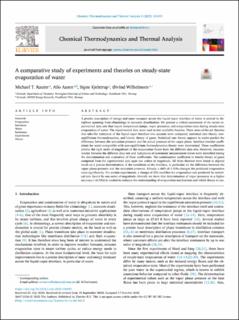| dc.contributor.author | Rauter, Michael Tobias | |
| dc.contributor.author | Aasen, Ailo | |
| dc.contributor.author | Kjelstrup, Signe Helene | |
| dc.contributor.author | Wilhelmsen, Øivind | |
| dc.date.accessioned | 2023-02-20T19:41:48Z | |
| dc.date.available | 2023-02-20T19:41:48Z | |
| dc.date.created | 2023-02-03T13:37:35Z | |
| dc.date.issued | 2022 | |
| dc.identifier.issn | 2667-3126 | |
| dc.identifier.uri | https://hdl.handle.net/11250/3052486 | |
| dc.description.abstract | A precise description of energy and mass transport across the liquid-vapor interface of water is central in dis- ciplines spanning from climatology to seawater desalination. We present a critical assessment of six recent ex- perimental data sets that report temperature jumps, vapor pressures, and evaporation rates during steady-state evaporation of water. The experimental data were used to test available theories. Three state-of-the-art theories that take the resistance of the liquid-vapor interface into account were compared; statistical rate theory, non- equilibrium thermodynamics, and kinetic theory of gases. Statistical rate theory appears to under-predict the difference between the saturation pressure and the actual pressure of the vapor phase. Interface transfer coeffi- cients for water compatible with non-equilibrium thermodynamics theory were determined. These coefficients predict the right order of magnitude of the evaporation fluxes from the different data sets. However, inconsis- tencies between the different data sets and indications of systematic measurement errors were identified during the determination and evaluation of these coefficients. The condensation coefficient in kinetic theory of gases computed from the experimental data span two orders of magnitude. All three theories were found to depend much on a precise determination of the conditions at the interface, in particular on the difference between the vapor phase pressure and the saturation pressure. Already a shift of 1–5 Pa changes the predicted evaporation rates significantly. For certain experiments, a change of 2 Pa modifies the evaporation rate predicted by statisti- cal rate theory by one order of magnitude. Overall, we show that determination of vapor pressures to a higher accuracy (<0.3 Pa) is needed to enhance the understanding of evaporation mechanisms and which theory to use | en_US |
| dc.language.iso | eng | en_US |
| dc.publisher | Elsevier B. V. | en_US |
| dc.rights | Attribution-NonCommercial-NoDerivatives 4.0 Internasjonal | * |
| dc.rights.uri | http://creativecommons.org/licenses/by-nc-nd/4.0/deed.no | * |
| dc.title | A comparative study of experiments and theories on steady-state evaporation of water | en_US |
| dc.title.alternative | A comparative study of experiments and theories on steady-state evaporation of water | en_US |
| dc.type | Journal article | en_US |
| dc.description.version | publishedVersion | en_US |
| dc.source.volume | 8 | en_US |
| dc.source.journal | Chemical Thermodynamics and Thermal Analysis | en_US |
| dc.identifier.doi | 10.1016/j.ctta.2022.100091 | |
| dc.identifier.cristin | 2122806 | |
| dc.relation.project | Norges forskningsråd: 262644 | en_US |
| dc.source.articlenumber | 100091 | en_US |
| cristin.ispublished | true | |
| cristin.fulltext | original | |

